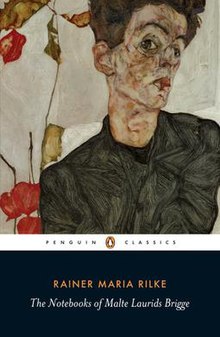The Notebooks of Malte Laurids Brigge
Appearance
You can help expand this article with text translated from the corresponding article in German. (June 2019) Click [show] for important translation instructions.
|
 | |
| Author | Rainer Maria Rilke |
|---|---|
| Original title | Die Aufzeichnungen des Malte Laurids Brigge |
| Translator | M. D. Herter Norton |
| Language | German |
| Genre | Expressionist novel |
| Publisher | Insel Verlag |
Publication date | 1910 |
| Publication place | Austria-Hungary |
| Pages | Two volumes; 191 and 186 p. respectively (first edition hardcover) |
The Notebooks of Malte Laurids Brigge, first published as Journal of My Other Self,[1] is a 1910 novel by Austrian poet Rainer Maria Rilke. The novel was the only work of prose of its length that he wrote and published. It is semiautobiographical and is written in an expressionistic style, dealing with themes of alienation, unfamiliarity, death by illness, longing, childhood memories and the Parable of the Prodigal Son. It was conceptualized and written whilst Rilke lived in Paris, mainly inspired by Sigbjørn Obstfelder's A Priest's Diary and Jens Peter Jacobsen's Niels Lyhne.
English translations
- John Linton (Norton, 1930; Hogarth Press, 1930). Originally published under the title The Journal of My Other Self.
- Mary D. Herter Norton (Norton, 1949)
- Stephen Mitchell (Random House, 1982)
- Burton Pike (Dalkey Archive, 2008)
- Michael Hulse (Penguin, 2009)
- Robert Vilain (Oxford, 2016)
- Edward Snow (Norton, 2022)
See also
References
- ^ M. D. Herter Norton (tr.). New York: W. W. Norton, 1949, 1992. Translator's Foreword, p. 8.
External links
Wikiquote has quotations related to Rainer_Maria_Rilke#The_Notebooks_of_Malte_Laurids_Brigge_(1910).
- Die Aufzeichnungen des Malte Laurids Brigge at Project Gutenberg (in German)
- Original text at zeno.org (in German)
